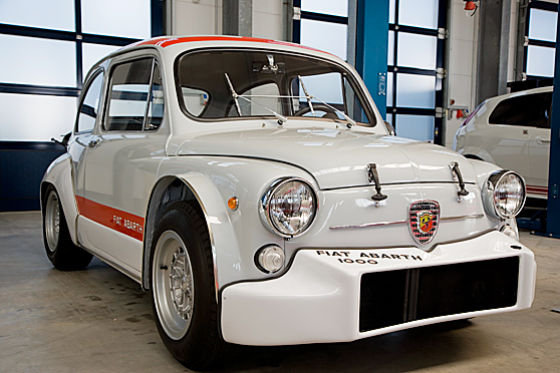TGR Staff – Updated 10/02/2024
There are few brands in the automotive world that evoke the same sense of raw, unbridled racing enthusiasm as
Abarth. Founded by Carlo Abarth in 1949, the Italian tuning house became synonymous with transforming small, unassuming Fiats into fire-breathing race machines. Among its most iconic creations is the Fiat Abarth 1000 TCR, a car that is not only a symbol of innovation but also a legend in motorsport history. Born in the mid-1960s, the 1000 TCR represents the high-water mark of Abarth’s ingenuity, its design adhering to a simple but thrilling principle: go faster by any means necessary.
o understand the significance of the Abarth 1000 TCR, we need to go back to the introduction of Group 5 racing in 1965. Group 5 was a new motorsport category that opened the door for tuners and manufacturers to flex their engineering muscles with fewer constraints. This class allowed teams to modify their cars to extreme levels, which gave birth to some of the wildest and most exhilarating race machines of the era. It was a playground for engineers, a place where they could test the limits of technology and creativity.
Abarth, known for its relentless pursuit of speed, embraced the Group 5 regulations with open arms. Carlo Abarth saw the potential to build a car that could compete with the best on the track, and the Fiat 1000 TCR (Turismo Competizione Radiale) was the result. Based on the humble
Fiat 600, this car was anything but ordinary. While its roots lay in an economy car meant for the masses, under the hood, the TCR was a beast designed to dominate the circuits.
At first glance, the Fiat Abarth 1000 TCR might not look like much. It retained much of the original Fiat 600’s boxy design, with a compact body that seemed unassuming. But this was part of Abarth’s magic: they knew how to turn an underdog into a champion. What made the TCR special wasn’t just what was visible on the outside, but the extensive modifications that lay beneath the surface.
The most notable aspect of the 1000 TCR was its engine. The original Fiat 600 came with a modest 600cc engine, but Abarth wasn’t content with that. They increased the engine displacement to 982cc, and with the help of dual Weber carburetors, an aggressive camshaft, and higher compression, they pushed the power output to around 110 horsepower. Now, that may not sound like much in today’s world of 300-horsepower hot hatches, but for a car that weighed less than 600 kg (about 1,320 pounds), this was more than enough to make it a formidable competitor.
The engine wasn’t the only thing that was radically reworked. The 1000 TCR’s cooling system was one of its most distinctive features. Given the limitations of the small engine bay and the increased heat from the upgraded engine, Abarth engineers relocated the radiator to the rear, directly behind the engine, and installed larger air intakes to improve airflow. The car’s signature feature became the dramatic “boxer” style rear end, where the rear hood was propped open to help dissipate heat and increase downforce—a solution that became an iconic symbol of Abarth’s unconventional but effective engineering.

Abarth didn’t stop at engine modifications. The 1000 TCR was also outfitted with significant changes to its suspension and brakes. Abarth upgraded the suspension to be much stiffer and more responsive, allowing the car to take corners with greater precision. Larger brakes were fitted to ensure the little Fiat could slow down just as quickly as it could speed up. Combined with the car’s low weight and short wheelbase, this made the TCR incredibly nimble. On tight and twisty circuits, the 1000 TCR was known for darting through corners with a level of agility that left many larger, more powerful cars in its wake.
The Fiat Abarth 1000 TCR wasn’t just a car built for show; it was designed to win races—and win it did. Competing primarily in the European Touring Car Championship (ETCC), the 1000 TCR quickly established itself as a giant killer on the track. Its lightweight and exceptional handling gave it a distinct advantage on shorter, more technical circuits, where raw power wasn’t as important as agility and control. The TCR dominated the 1,000cc class, and its success cemented Abarth’s reputation as a serious contender in international motorsport.
Drivers who piloted the Abarth 1000 TCR often spoke about its lively and somewhat unpredictable nature. It was a car that demanded respect; while it was quick and nimble, it was also prone to oversteer due to its rear-engine layout. Those who mastered its quirks, however, could extract exceptional performance from the machine. The TCR was especially feared in endurance events, where its durability and consistent speed allowed it to compete against larger, more powerful cars over long distances.
The Fiat Abarth 1000 TCR is more than just a piece of automotive history—it’s a symbol of a bygone era of motorsport, where creativity and passion often trumped the constraints of regulations. The TCR exemplifies the Abarth ethos: take something simple, strip away the unnecessary, and extract the maximum potential. Its legacy is felt not just in the world of motorsport but also in the broader automotive culture. Today, the Abarth 1000 TCR is a highly sought-after collector’s item, cherished by enthusiasts who appreciate its unique place in racing history.
In many ways, the Abarth 1000 TCR was ahead of its time. It anticipated the rise of homologation specials and small, lightweight race cars that would go on to dominate circuits for decades to come. While Abarth’s name is often associated with its collaborations with Fiat, it’s cars like the 1000 TCR that truly showcase the brand’s rebellious spirit and innovative approach to performance.
The Fiat Abarth 1000 TCR stands as a testament to what can be achieved when passion meets engineering. It’s a car that exemplified the best of Abarth’s ethos: pushing the limits, taking risks, and always finding a way to go faster. From its humble Fiat 600 roots to its racing pedigree, the 1000 TCR is a reminder that, in the world of motorsport, even the smallest cars can leave the biggest mark.
Post Views: 587




